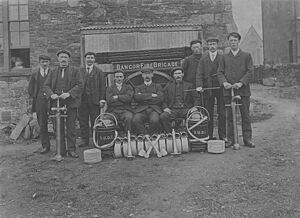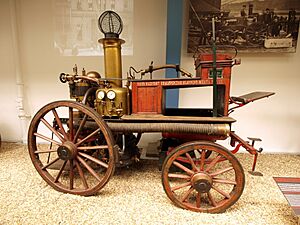History of the Belfast Fire Brigade facts for kids
The Belfast Fire Brigade was a special group of firefighters who protected the city of Belfast for many years. It started way back in 1800. For a long time, until 1861, it worked closely with the local police. After that, it became a dedicated firefighting service. In 1973, it joined with the Northern Ireland Fire Authority, which is now known as the Northern Ireland Fire and Rescue Service.
Contents
Early Firefighting in Belfast
The first settlement that grew into Belfast was near a place where people could cross the River Lagan. This was around the 600s. Later, in 1306, there was a chapel near this crossing, where St George's Church, Belfast stands today. Back then, church bells might have been the first way to tell people there was a fire, so they could rush to help put it out.
For many years, firefighting tools were very simple. People used basic hand tools, ladders, and leather buckets to carry water from rivers or wells to the fire.
A big fire happened on April 25, 1708, at Belfast Castle. Five young women died, and the castle was completely destroyed. The firefighting equipment wasn't good enough to stop the fire. Around 1740, a record about the Belfast Fire Brigade mentioned how they tried to improve things: "They decided to make holes in Front Street (now High Street) to get water from the river below. They also made six movable barrel pumps and trained six men to use them. These men were paid a small salary and extra money each time they fought a real fire. This was the Fire Brigade over 90 years ago!"
The 1800s: A New Start
In 1800, the Belfast Police Act created the Belfast Police Board. This group was in charge of keeping the streets clean, removing problems, and having a night watch. They also created a uniformed police force, the Belfast Borough Police, who helped fight fires too. They quickly spent money to buy a new fire engine from a company in London.
In the early 1800s, the Belfast Corporation tried to get money from insurance companies to help the Fire Brigade, but not much was given. This was different from other big cities in England and Scotland, where insurance companies often helped fund fire services.
In 1840, Belfast bought its first steam-powered fire engine. A company called Merryweather & Sons delivered it the next year. This new engine made it much faster for firefighters to get to fires and helped them cover a larger area of the city.
From 1860 to 1861, Eyre Massey Shaw led the Belfast Fire Brigade. Even though he was only there for a short time, he wrote important reports about big fires in Belfast. He pointed out that the city's water pipes were not good enough. In 1861, Massey Shaw left Belfast to become the leader of the London Fire Engine Establishment, and later the first chief of the London Fire Brigade.
After Massey Shaw left, it was decided to separate the Police and the Fire Brigade. George Reilly became the first superintendent (leader) of the Fire Brigade, serving until 1891. In 1892, after Reilly retired, the Belfast Corporation made the Fire Brigade fully professional. Under the new leader, Superintendent George Parker, firefighters got new protective uniforms and equipment. Other big changes included getting rid of part-time firefighters, changing work schedules, and improving pay.
In May 1894, the new Belfast Fire Brigade headquarters and fire station opened on Chichester Street. It had a fire station, offices, homes for firefighters and their families, rooms for single firefighters, and a large training yard with a tall drill tower.
The 1900s: Modern Changes
As the 20th century began, Belfast's population grew quickly. This meant the city needed more fire stations. Between 1904 and 1905, new stations opened in areas like Ardoyne, Albert Bridge Road, the Shankill Road, and Whitla Street.
Cars were becoming popular, and this technology was soon used for fire engines. In 1911, the Belfast Fire Brigade became the first in the United Kingdom to have all its fire engines powered by motors. This big step forward meant that horse-drawn steam engines were no longer needed.
World War II and the Blitz
In the late 1930s, as war seemed likely in Europe, Belfast prepared for possible air attacks from Germany. The Belfast Corporation created the Auxiliary Fire Service (AFS). These part-time firefighters had limited equipment and training, but they were very important in helping the full-time firefighters of the Belfast Fire Brigade.
In the spring of 1941, German planes attacked Belfast from the air. On Easter Tuesday night in 1941, about 180 German planes dropped bombs and thousands of incendiary bombs (which cause fires) on the city. Almost 1,000 people were killed, and over 100,000 people lost their homes. Two AFS firefighters died while working in York Street.
Fire Brigades from the Republic of Ireland also came to help during these attacks. The border between Northern Ireland and the Republic of Ireland stayed open during the Blitz. For many years after, the Belfast Fire Brigade and the Dublin Fire Brigade even had an annual soccer match!
In 1942, a law was passed in Northern Ireland to create a National Fire Service (NFS). This was done to help local Fire Brigades work better together during the war.
After the War
After World War II ended in 1945, the government decided to break up the NFS and give control back to local areas. In 1947, four Fire Brigades were created in Northern Ireland: Northern Command, Southern Command, Western Command, and Belfast City.
In 1950, these four brigades became two main fire authorities: the 'Belfast Fire Brigade' for Belfast, and the 'Northern Ireland Fire Authority' for the other three areas. In 1951, a central control room was set up in Lisburn. This room could keep track of fire engines and incidents across Northern Ireland.
As Belfast recovered and rebuilt after the Blitz, more fire stations were needed. On October 5, 1954, the Cadogan fire station opened. This station was different from older ones because firefighters and their families no longer lived at the station. Firefighters only had to be at the station during their work hours, which were 84 hours a week at that time.
In the late 1960s, there was a lot of civil unrest in Northern Ireland. In April 1969, three water pipes that supplied water to Belfast were blown up. To get enough water for firefighting, different businesses lent their vehicles, like milk, petrol, and drinks tankers, to carry water to the city. On one night, 10 buildings were attacked, which really tested the firefighters. The Chief Fire Officer, Captain R.Mitchell, said it must have been strange for people to see firefighters putting out fires with what looked like milk or Guinness! But he added that the Fire Service has always been able to adapt.
Joining Forces
In the early 1970s, the government wanted to reduce the number of local councils. After talking with the Fire Brigades Union (FBU), it was decided that the best idea was to combine the two Fire Brigades in Northern Ireland.
So, on October 1, 1973, the Northern Ireland Fire Brigade became one combined Fire Brigade for all of Northern Ireland. This meant the Belfast Fire Brigade, with its long and important history, became part of the past.
The Belfast Fire Brigade had a unique round cap badge. Its motto was 'Pro Tanto Quid Retribuamus', which means 'For what we give, what shall we receive'. This motto still reminds people of the brave service firefighters have given for centuries.
Mr. George Morrison, who used to lead the Northern Ireland Fire Authority, became the first Chief Fire Officer of the new Northern Ireland Fire Brigade (NIFB).



